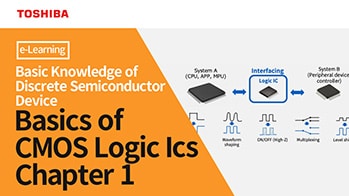- General Top
- SEMICONDUCTOR
- STORAGE
- COMPANY
-
My ToshibaSemicon
- Semiconductor Top
-
ApplicationsAutomotive
Body Electronics
xEV
In-Vehicle Infotainment
Advanced Driver-Assistance Systems (ADAS)
Chassis
IndustrialInfrastructure
BEMS/HEMS
Factory Automation
Commercial Equipment
Consumer/PersonalIoT Equipment
Healthcare
Wearable Device
Mobile
Computer Peripherals
-
ProductsAutomotive Devices
Discrete Semiconductor
Diodes
Transistors
Logic ICs
Analog Devices
Digital Devices
Wireless Devices
※
: Products list (parametric search)
Power Semiconductors※
: Products list (parametric search)
Isolators/Solid State RelaysPhotocouplers
Digital Isolators
Solid State Relays
Fiber Optic Transmitting Modules
※
: Products list (parametric search)
MOSFETsIGBTs/IEGTsBipolar Transistors※
: Products list (parametric search)
Diodes※
: Products list (parametric search)
MicrocontrollersMotor Driver ICsIntelligent Power ICs※
: Products list (parametric search)
Power Management ICsLinear ICs※
: Products list (parametric search)
General Purpose Logic ICsLinear Image SensorsOther Product ICsOther Product ICs
※
: Products list (parametric search)
-
Design & Development
-
Knowledge
- Where To Buy
- Part Number & Keyword Search
- Cross Reference Search
- Parametric Search
- Stock Check & Purchase
This webpage doesn't work with Internet Explorer. Please use the latest version of Google Chrome, Microsoft Edge, Mozilla Firefox or Safari.
require 3 characters or more. Search for multiple part numbers fromhere.
The information presented in this cross reference is based on TOSHIBA's selection criteria and should be treated as a suggestion only. Please carefully review the latest versions of all relevant information on the TOSHIBA products, including without limitation data sheets and validate all operating parameters of the TOSHIBA products to ensure that the suggested TOSHIBA products are truly compatible with your design and application.Please note that this cross reference is based on TOSHIBA's estimate of compatibility with other manufacturers' products, based on other manufacturers' published data, at the time the data was collected.TOSHIBA is not responsible for any incorrect or incomplete information. Information is subject to change at any time without notice.
require 3 characters or more.
How can I calculate the maximum operating frequency of a level shifter (voltage translation logic IC)?
Buffer type products and bus switch type products have different calculation methods for the operating frequency. Buffer type products can be calculated based on the propagation delay time obtained from the CR values of the load and on-resistance. On the other hand, bus switch type products can be calculated based on the load and on-resistance CR time constant.
Each calculation method is briefly described below.
- The maximum operating frequency of the bus buffer type can be calculated from the propagation delay times (tpLH, tpHL) as shown below.
Maximum operating frequency ≈ 1/(tpLH + tpHL) - The maximum operating frequency of the bus switch type can be calculated based on the CR time constant of the load and on-resistance.
Maximum operating frequency ≈ 1/(τ), where τ is a time constant:
Since τ is determined by charging and discharging time, τ is calculated from the time required for the output voltage to reaches 63 %. (See the Fig. 1.)
1/τ = 1/(C×R)
For example, the TC7SPB9306 with a switch I/O capacitance (CI/O) of 14 pF. Assume a load capacitance (CL) of 30 pF and a pullup resistor (Rpu) of 1 kΩ. Then, τ is calculated as follows:
τ = (14 pF + 30 pF) × 1 kΩ
Hence, the maximum operating frequency is calculated as roughly 20 MHz
- Refer to the following FAQ for recommended level shifters that are compatible with the communications standard.
FAQ: Are there level shifters (voltage translation IC) compatible with serial communication standards (UART, I2C)?
The result of this calculation should be considered merely as an estimate under the conditions shown in the datasheet.
Level shifters should be sufficiently evaluated to ensure that they work properly under the actual operating conditions because their propagation delay times change with the board capacitance and other conditions.

Related Links
The following documents also contain related information.




